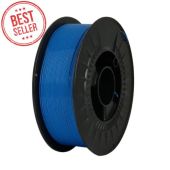PETG Retraction Settings
Understanding PETG and Why Retraction Matters
PETG, or Polyethylene Terephthalate Glycol, is one of the most widely used materials in desktop 3D printing. It offers a strong balance of toughness and printability, combining the durability of ABS with the ease of PLA. That makes it popular for everything from functional prototypes to finished parts.
A common issue with PETG is stringing, those thin, unwanted plastic threads that stretch between travel moves. The main factor behind this problem is retraction. Retraction occurs when the extruder pulls filament back during travel moves, releasing pressure in the nozzle and reducing the chance of excess material leaking out.
Getting retraction right is crucial. If settings are too low, stringing and blobs appear. If they are too high, the result may be grinding, clogs, or under-extrusion. Finding the right balance in PETG retraction settings is one of the key steps to producing clean, high-quality prints.
Typical Retraction Parameters for PETG
Although every printer and brand of filament behaves slightly differently, there are reliable starting points for PETG that serve as a baseline:
- Retraction distance: Direct drive extruders often work best with 0.5–2 mm, while Bowden extruders need slightly more, usually 3–6 mm. Going further than this often causes jams.
- Retraction speed: A range of 20–45 mm/s is effective. Too fast risks grinding, too slow may not stop stringing.
- Nozzle temperature: PETG prints well between 230 and 250 °C. Printing hotter increases stringing, while cooler temperatures may weaken layer adhesion.
- Travel speed: Higher travel speeds, ideally above 150 mm/s, reduce the chance of filament leaking.
- Advanced slicer options: Features like coasting and wipe can further improve quality by relieving nozzle pressure and avoiding blobs.
These figures provide a solid framework, but careful fine-tuning is always necessary for your particular printer and filament.
Practical Tips for Reducing Stringing in PETG
Optimizing retraction settings for PETG is about more than a single parameter. You need to consider how temperature, retraction, travel, and filament condition interact. A few tips can make a big difference:
- Start with calibration prints like retraction towers or stringing tests to see how adjustments affect results.
- Lower nozzle temperature slightly, usually by 5–10 °C, if you see excessive stringing.
- Keep PETG dry by storing it in airtight containers with desiccant or drying spools before printing.
- Increase travel speed so the nozzle moves quickly between areas, leaving less time for oozing.
- Experiment with slicer features like coasting and wipe for smoother finishes.
- Maintain your hardware by cleaning extruder gears and ensuring the nozzle is not clogged or worn.
These adjustments, made step by step, will help reduce stringing and improve surface finish.
Balancing Retraction and Flow
PETG is naturally sticky, which is why it bonds strongly but also strings easily. Over-retraction can be as problematic as under-retraction, since it can grind filament or cause gaps in extrusion.
The best approach is to adjust gradually. Increase retraction distance in small increments, no more than 0.5 mm at a time, and fine-tune retraction speed within a safe range. Each change should be tested with a calibration print to confirm improvements before applying it to larger projects.
Common Mistakes When Setting Retraction for PETG
Many users fall into the same traps when adjusting PETG settings. A frequent mistake is copying PLA settings, which usually do not transfer well. Another is setting retraction distance too high, particularly with Bowden setups, which often leads to clogs rather than improvements.
Temperature is also overlooked—printing too hot or with moisture-laden filament will create persistent stringing regardless of retraction. Finally, many beginners skip calibration prints, making blind adjustments that waste time and filament.
Avoiding these errors speeds up the process of dialing in a stable setting.
Conclusion
Printing PETG successfully requires balancing retraction with temperature, travel speed, and filament condition. Retraction is a powerful tool for reducing stringing, but it works best when combined with other optimized settings.
By starting with recommended baselines, running calibration tests, and making careful adjustments, you can achieve clean PETG prints with minimal post-processing.
At 3D Trček, we provide high-quality filaments and 3D printing materials designed to deliver consistent, reliable results, so you can focus on achieving the best outcomes in your projects.
; ?>) Shop PETG Filament
Shop PETG Filament


Please complete your information below to login.
Anmelden
Neuen Account erstellen